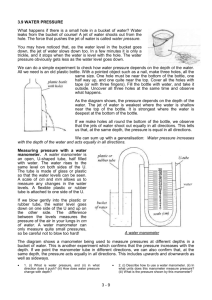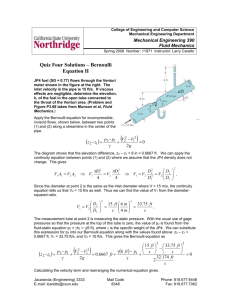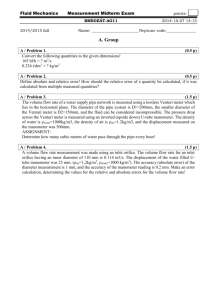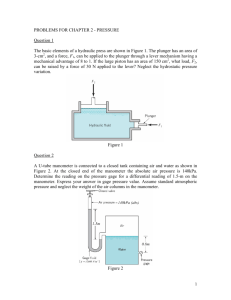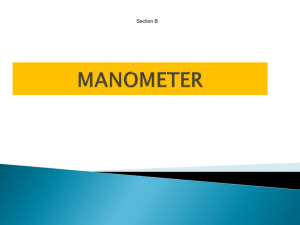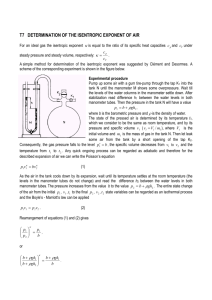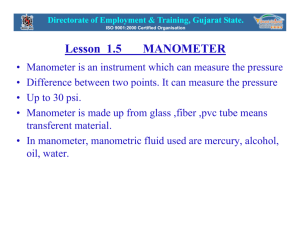here - Users.waitrose.com
advertisement
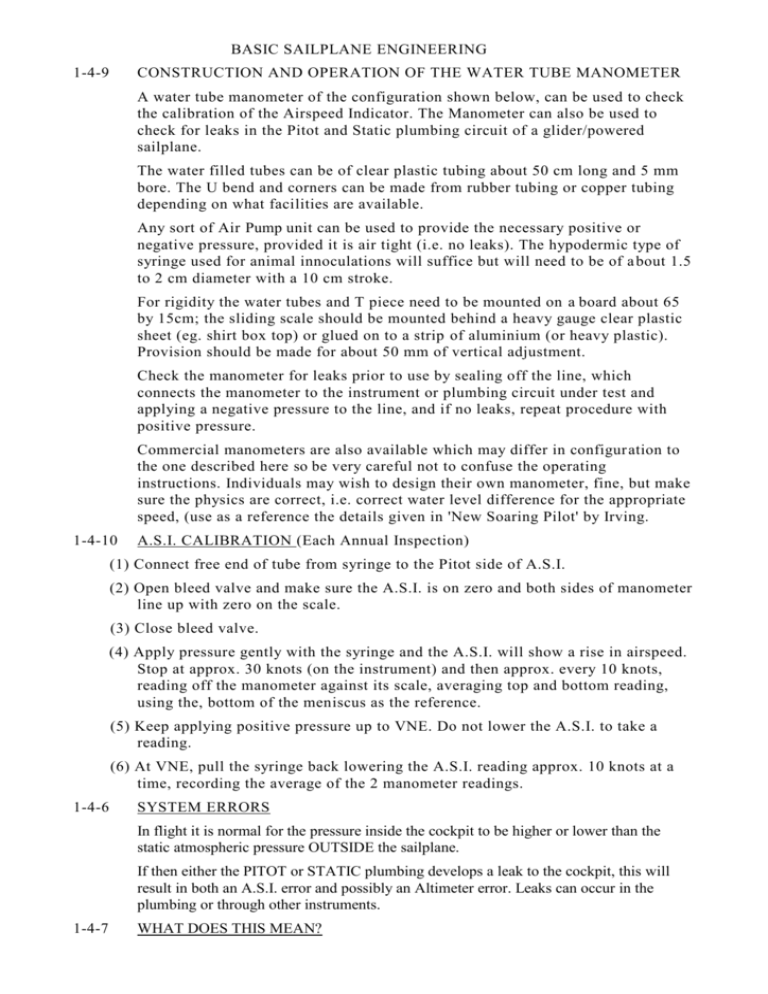
BASIC SAILPLANE ENGINEERING 1-4-9 CONSTRUCTION AND OPERATION OF THE WATER TUBE MANOMETER A water tube manometer of the configuration shown below, can be used to check the calibration of the Airspeed Indicator. The Manometer can also be used to check for leaks in the Pitot and Static plumbing circuit of a glider/powered sailplane. The water filled tubes can be of clear plastic tubing about 50 cm long and 5 mm bore. The U bend and corners can be made from rubber tubing or copper tubing depending on what facilities are available. Any sort of Air Pump unit can be used to provide the necessary positive or negative pressure, provided it is air tight (i.e. no leaks). The hypodermic type of syringe used for animal innoculations will suffice but will need to be of a bout 1.5 to 2 cm diameter with a 10 cm stroke. For rigidity the water tubes and T piece need to be mounted on a board about 65 by 15cm; the sliding scale should be mounted behind a heavy gauge clear plastic sheet (eg. shirt box top) or glued on to a strip of aluminium (or heavy plastic). Provision should be made for about 50 mm of vertical adjustment. Check the manometer for leaks prior to use by sealing off the line, which connects the manometer to the instrument or plumbing circuit under test and applying a negative pressure to the line, and if no leaks, repeat procedure with positive pressure. Commercial manometers are also available which may differ in configur ation to the one described here so be very careful not to confuse the operating instructions. Individuals may wish to design their own manometer, fine, but make sure the physics are correct, i.e. correct water level difference for the appropriate speed, (use as a reference the details given in 'New Soaring Pilot' by Irving. 1-4-10 A.S.I. CALIBRATION (Each Annual Inspection) (1) Connect free end of tube from syringe to the Pitot side of A.S.I. (2) Open bleed valve and make sure the A.S.I. is on zero and both sides of manometer line up with zero on the scale. (3) Close bleed valve. (4) Apply pressure gently with the syringe and the A.S.I. will show a rise in airspeed. Stop at approx. 30 knots (on the instrument) and then approx. every 10 knots, reading off the manometer against its scale, averaging top and bottom reading, using the, bottom of the meniscus as the reference. (5) Keep applying positive pressure up to VNE. Do not lower the A.S.I. to take a reading. (6) At VNE, pull the syringe back lowering the A.S.I. reading approx. 10 knots at a time, recording the average of the 2 manometer readings. 1-4-6 SYSTEM ERRORS In flight it is normal for the pressure inside the cockpit to be higher or lower than the static atmospheric pressure OUTSIDE the sailplane. If then either the PITOT or STATIC plumbing develops a leak to the cockpit, this will result in both an A.S.I. error and possibly an Altimeter error. Leaks can occur in the plumbing or through other instruments. 1-4-7 WHAT DOES THIS MEAN? EXAMPLE: Our Mini Nimbus pilot is at the end of a task and figures that a final glide at 100 knots will see. him home: INDICATED SPEED seen by the pilot (I.A.S.) .. INSTRUMENT ERROR from 1-4-5 The pilot SHOULD see 7.5 kts (B.A.S.) .. POSITION ERROR from 1-4-4 at 92.5 kts So ACTUAL speed through the air 100 knots 92.5 kts 6.0 kts (C.A.S.) .. 86.5 kts (To bring this to TRUE AIRSPEED both temperature and height would then need to be considered). THE IMPLICATIONS ARE OBVIOUS: (1) The COCKPIT PLACARDS must be marked with INDICATED SPEEDS, after taking into account the effect of Position error: (2) Both the PITOT and STATIC plumbing systems must be known to be LEAK FREE. (3) If any AIRSPEED INDICATOR calibrates with errors higher than the recommendations in 1-4-8 then it must be overhauled by a suitable workshop. 1-4-8 IN FLIGHT SAFETY The example above shows the pilot flying a lot slower than he thinks, BUT it could just as easily be the other way; (1) CIRCUIT SPEED: We all aim to fly our circuits at or around the magic 50 knots. If our accumulated errors are going to give us a lower airspeed in the circuit, this will create a potential danger by lowering our safety margin. (2) MANOUEVRE SPEED: ROUGH AIR SPEED: TOW SPEED: DIVE SPEED Each of these speeds must be respected since exceeding them can cause both structural failure, or flutter, possibly both. Where necessary it may be practical to put a placard adjacent to the A.S.I. that takes the instrument errors into account: EXAMPLE: FOR 40 60 70 READ 34 64 73 Placed adjacent to the A.S.I. (7) Do not raise the pressure while coming down from VINE. (8) Example of calibration – MANOMETER OR Instrument reading Instrument reading CALIBRATED ASI increasing kts. Decreasing Stall 32 30 32 41 39 41 53 52 53 62 62 61 70 71 70 VNE 91 92 90 104 107 104 110 126 126 (9) Low indicated speeds near stall and high indicated speeds near the maximum permissible speeds means that the ASI is erring on the safe side as the glider will be flying faster than indicated near the stall and slower than indicated at the maximum permissible speeds (e.g. Max Rough, Max. Aero-tow, Never Exceed Speed, etc.) NB A fishtank air pump has proved to be much easier to use than the syringe illustrated., but a suitable valve to give fine control of air flow is essential.
